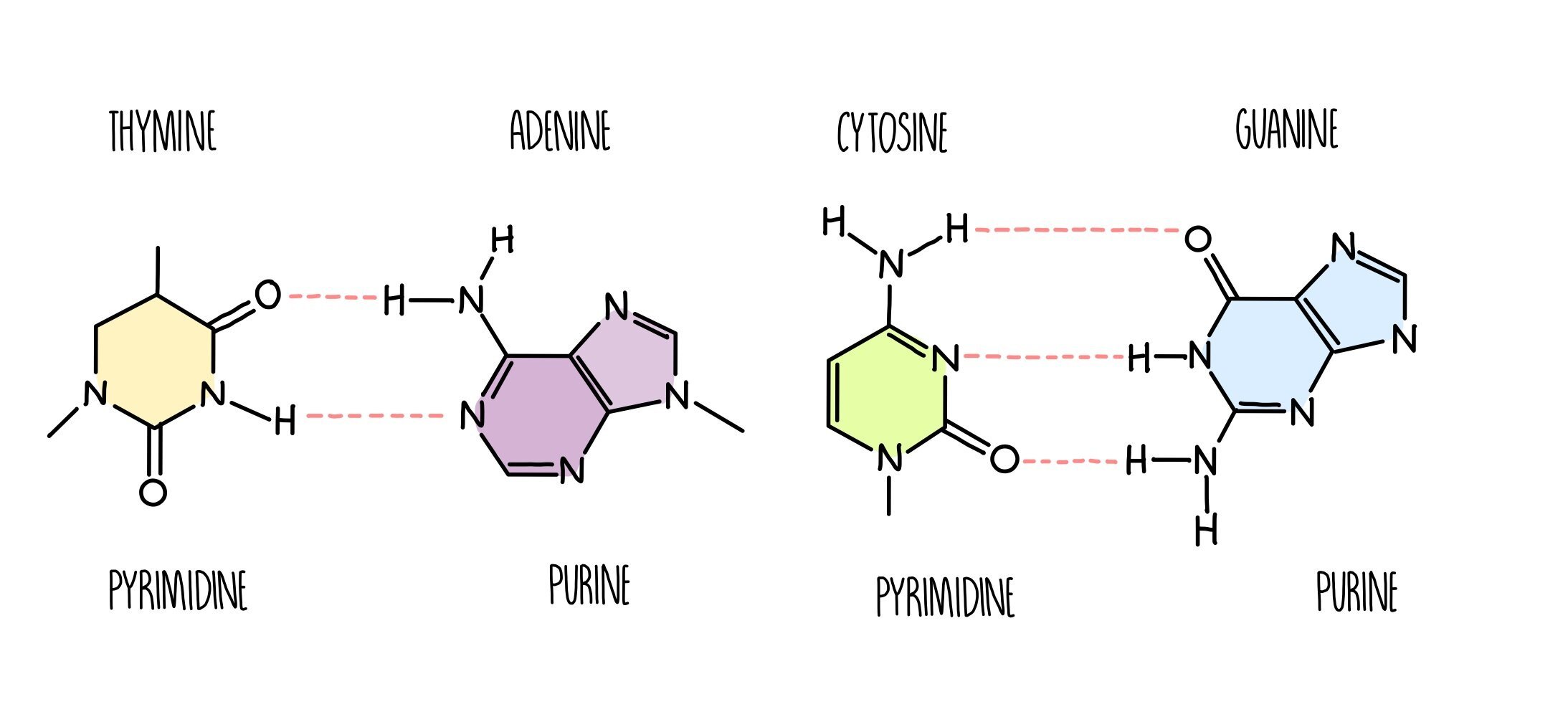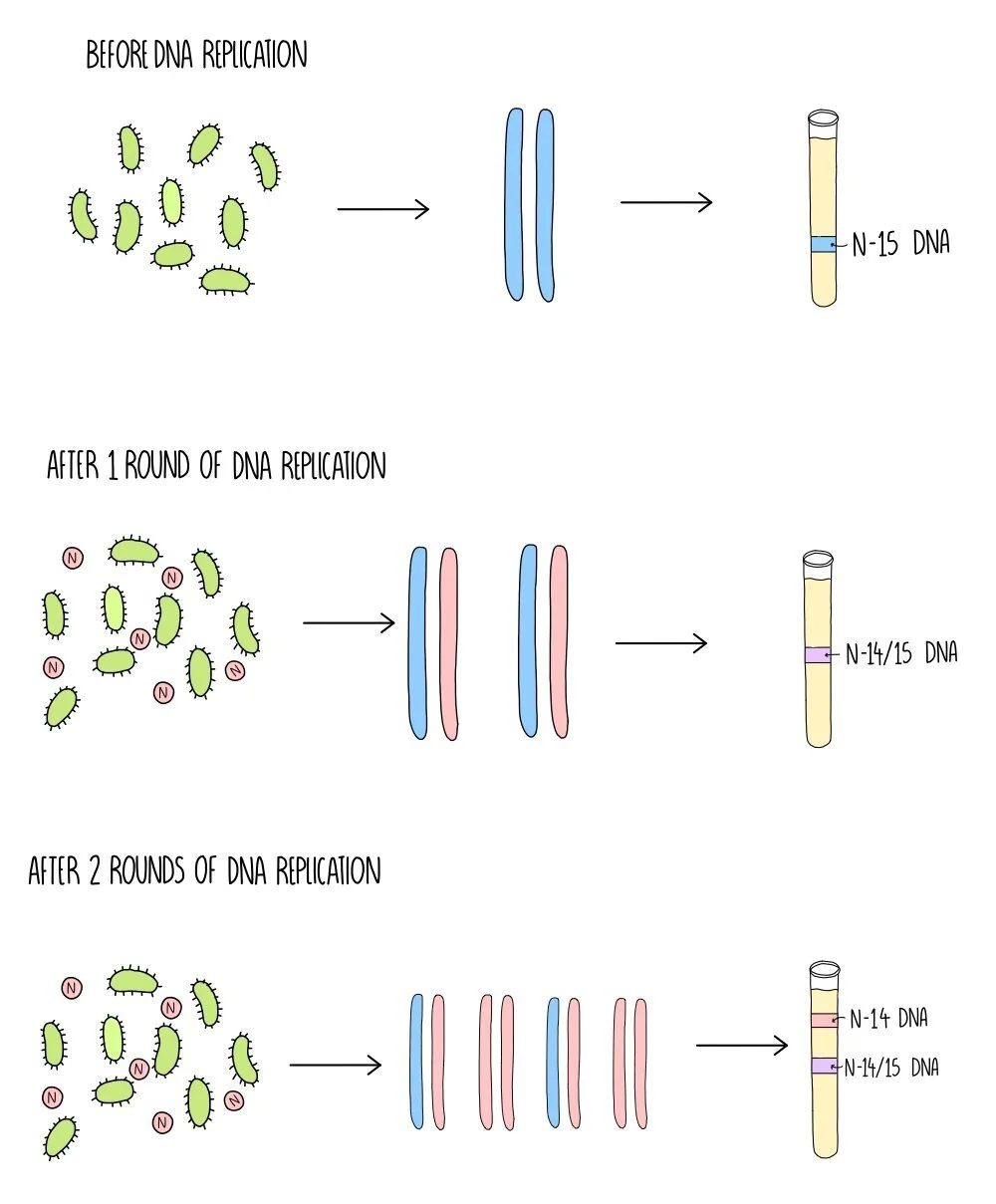Nucleic Acids and Replication
Nucleic acids
Nucleic acids are long chains (polymers) made up of many nucleotide monomers joined together by phosphodiester bonds. Each nucleotide is made up of three components:
Pentose sugar (either deoxyribose or ribose),
Nitrogenous base (guanine, cytosine, adenine, thymine or uracil)
Phosphate
DNA consists of two nucleic acid strands bonded together by complementary base pairing, the strands twisted around each other to form a double helix. The two strands have the same sequence running in opposite directions so we say they are anti-parallel. The bonding between bases is predictable, since guanine always pairs with cytosine with three hydrogen bonds holding them together. Adenine always bonds with thymine (in DNA) or uracil (in RNA) with two hydrogen bonds between them. Adenine and guanine are purines, which have a large double ring structure. Cytosine and thymine are pyrimidines, which are smaller as they are composed of a single ring. Notice that a purine always base pairs with a pyrimidine - this happens because it’s the only way DNA can keep a regular shape and not become too bulky or narrow.
There are some important differences between a molecule of DNA and RNA:
They contain different sugars - the pentose sugar in DNA is deoxyribose and in RNA is ribose. The difference is that deoxyribose has one less oxygen atom.
RNA contains uracil instead of thymine
DNA is double-stranded whereas RNA is single-stranded
DNA has hydrogen bonds between the two complementary strands
During DNA and RNA synthesis, nucleotides are connected through the formation of phosphodiester bonds (a type of covalent bond) between the phosphate group on one nucleotide and the pentose sugar of the next nucleotide. It is a condensation reaction which means that water is formed during the reaction and it is catalysed by an enzyme called DNA polymerase or RNA polymerase depending on whether a DNA or RNA strand is being synthesised. Breaking phosphodiester bonds requires the addition of a water molecule, so it is a hydrolysis reaction.
Semi-conservative DNA replication
During cell division, cells need to make a complete copy of their genetic information. When DNA is replicated, the new DNA molecule is made up of one strand of the original DNA whereas the other strand is made of freshly made DNA. Since half of the DNA is preserved from the previous round of DNA replication, we describe the process as semi-conservative. It takes place in the following stages:
DNA helicase unwinds the double helix, breaking the hydrogen bonds between complementary base pairs to separate the strands. One of the strands will act as a template for synthesis of the other strand.
Complementary nucleotides will attach to the template strand by hydrogen bonding.
DNA polymerase catalyses the formation of phosphodiester bonds between nucleotides, forming a complementary strand alongside the template parent strand.
Two daughter DNA molecules are formed, each containing half of the original DNA molecule.
It is important that DNA polymerase accurately copies the template strand to avoid placing the wrong DNA nucleotide in the incorrect position. To avoid this, DNA polymerase ‘proofreads’ the complementary strand as it moves along the DNA. If it detects a mismatch, it can ‘snip out’ the wrong nucleotide and replace it with the right one. DNA polymerase has an accuracy rate of about 99%, which means that mistakes do occur every once in a while. A mistake results in a change to the DNA base sequence, which is known as a mutation. DNA mutations can have detrimental effects to the organism, since an altered base sequence can change the sequence of amino acids in a protein, causing it to fold differently and possibly lose its function.
Meselson and Stahl’s experiment
The evidence that DNA replication is semi-conservative comes from a pretty clever experiment carried out by Matthew Meselson and Franklin Stahl. Before this, scientists were unsure whether DNA replication was conservative or semi-conservative. If DNA replicated conservatively, the original DNA strands would remain intact and the newly synthesised DNA would consist of two freshly-made strands.
To figure this out they used a heavy isotope of nitrogen (N-15) which has an extra neutron compared to the normal, lighter form of nitrogen (N-14). They grew bacteria in the presence of the heavy nitrogen and any new DNA that the bacteria made would incorporate this isotope and so would weigh heavier. If DNA replicates conservatively, Meselson and Stahl knew that they’d see some DNA made of just heavy nitrogen with the rest made of only light nitrogen, but if it replicated semi-conservatively it would be a mixture of the two isotopes. Here’s how they carried out the experiment in more detail:
Two populations of bacteria were grown - one in a solution containing heavy nitrogen and the other in a solution containing light nitrogen. As the bacteria grow and reproduce, they incorporate the nitrogen into their DNA.
DNA was extracted from the bacteria and centrifuged to separate the DNA according to its weight. The DNA from the bacteria grown in N-15 separated at a higher density (a band lower down the test tube) compared to the DNA from the bacteria grown in N-14.
The scientists then took the bacteria that had been growing in N-15 (which now just contains heavy DNA) and grew them in the light isotope N-14. Again, they extracted their DNA and separated it using centrifugation.
After the first round of DNA replication, they saw just one band of DNA which was an intermediate weight between 14-N and 15-N. This indicates that the DNA was made up of both types of nitrogen isotopes (i.e. one old strand and one newly synthesised strand).
After the second round of DNA replication, there are now 2 bands of DNA. One band has an intermediate weight but further newly synthesised DNA is now only being made using the lighter isotope. This proved that DNA is replicated semi-conservatively.
If DNA replication is conservative, Meselson and Stahl would have seen two bands of DNA (one heavy and one light) after both the first and second rounds of replication.


